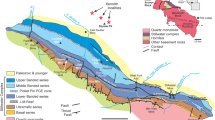Abstract
The microtextures developed during relatively slow cooling as a function of bulk composition in zoned ternary feldspars from syenodiorites and syenites in the Klokken intrusion, described in the preceding paper, were determined by TEM and their origin and evolution deduced. The feldspars normally have a plagioclase core and an alkali feldspar rim; cores become smaller and rims larger and the An content of both decrease with distance from the contact of the intrusion. The following microtextural sequence was observed. The inner plagioclase cores are homogeneous oligoclase-andesine with Albite growth twins only, but are crypto-antiperthitic towards the outer core. At first small platelets of low sanidine a few nanometres thick and up to ∼10 nm long occur sporadically only on Albite-twin composition planes. With further increase in bulk Or they are homogeneously distributed in the plagioclase. Thicker, through-going plates in platelet-free areas are found, which induce Albite twins in the surrounding plagioclase. The microtextures in the rims are regular cryptomesoperthitic, with (¯601) lenses or lamellae, depending on the bulk Or-content, of low sanidine in Albite-twinned low oligoclase-andesine. Albite and Pericline twins in plagioclase in an M-twin relationship, together with lenticular low sanidine, were found in only one small area. The overall diffraction symmetry of the mesoperthites is monoclinic, showing that exsolution started in a monoclinic feldspar, whereas that of the antiperthites is triclinic. The intermediate zone between the core and rim is more complex and microtextures vary over distances of a few micrometres.
The cryptomesoperthites are very regular where Or-rich and probably arose by spinodal decomposition. The platelets in the outer cores arose by heterogeneous nucleation on twin composition planes and by homogeneous nucleation elsewhere. Near the intermediate zone they coarsened to give larger plates which induced Albite-twins in the plagioclase. Because of the zoning, microtextures that were initiated in areas of given composition, can propagate laterally into zones of different composition. A diagram is given showing the relationship between ternary bulk composition and the microtexture developed in coherent perthitic alkali feldspars and plagioclases from slowly-cooled rocks.
Similar content being viewed by others
References
Brown WL, Parsons I (1983) Nucleation on perthite-perthite boundaries and exsolution mechanisms in alkali feldspars. Phys Chem Mineral 10:55–61
Brown WL, Parsons I (1984a) Exsolution and coarsening mechanisms and kinetics in an ordered cryptoperthite series. Contrib Mineral Petrol 86:3–18
Brown WL, Parsons I (1984b) The nature of potassium feldspar, exsolution microtextures and development of dislocations as a function of composition in perthitic alkali feldspars. Contrib Mineral Petrol 86:335–341
Brown WL, Parsons I (1985) Calorimetric and phase diagram approaches to two-feldspar geothermometry: a critique. Am Mineral 70:356–361
Brown WL, Willaime C (1974) An explanation of exsolution orientations and residual strain in cryptoperthites. In: MacKenzie WS, Zussman J (eds). The feldspars, Manchester Univ Press, pp 440–459
Brown WL, Becker SM, Parsons I (1983) Cryptoperthites and cooling rate in a layered syenite pluton: a chemical and TEM study. Contrib Mineral Petrol 82:13–25
Fleet ME (1982) orientation of phase and domain boundaries in crystalline solids. Am Mineral 67:926–936
Gray NH, Anderson JB (1982) Polysynthetic twin width distributions in anorthoclase. Lithos 15:27–37
Kroll H, Bambauer H-U (1981) Diffusive and displacive transformations in plagioclase and ternary feldspar series. Am Mineral 66:763–769
Kroll H, Bambauer H-U, Schirmer U (1980) The high albite-monalbite and analbite-monalbite transitions. Am Mineral 65:1192–1211
McLaren AC (1978) Defects and microstructures in feldspars. Chem Phys Solids Interfaces, Chem Soc London, 7:1–30
Parsons I (1979) The Klokken gabbro-syenite complex, South Greenland: cryptic variation and origin of inversely graded layering. J Petrol 20:653–694
Parsons I (1981) The Klokken gabbro-syenite complex, South Greenland: quantitative interpretation of mineral chemistry. J Petrol 22:233–260
Parsons I, Becker SM (1987) Layering, compaction and post-magmatic processes in the Klokken intrusion. In: Parsons I (ed) Origins of Igneous Layering. Reidel, Dordrecht, pp 29–92
Parsons I, Brown WL (1983) A TEM and microprobe study of a two-perthite alkali gabbro: implications for the ternary feldspar system. Contrib Mineral Petrol 81:1–12
Parsons I, Brown WL (1984) Feldspars and the thermal history of igneous rocks. In: Brown WL (ed) Feldspars and feldspathoids. Reidel, Dordrecht, pp 317–371
Parsons I, Brown WL (1988) Sidewall crystallization in the Klokken intrusion: zoned ternary feldspars and coexisting minerals. Contrib Mineral Petrol 98:431–443
Ried H, Korekawa M (1978) Twinning and exsolution in an antiperthite. Phys Chem Mineral 3:263–270
Salje E, Kuscholke B, Wruck B (1985) Domain wall formation in minerals I: theory of twin boundary shapes in Na-feldspar. Phys Chem Mineral 12:132–140
Smith JV, Brown WL (1988) Feldspar minerals, vol. 1. Springer, Berlin Heidelberg New York Tokyo
Smith JV, MacKenzie WS (1958) The alkali feldspars IV. The cooling history of high-temperature sodium-rich feldspars. Am Mineral 43:872–889
Willaime C, Brown WL (1974) A coherent elastic model for the determination of the orientation of exsolution boundaries: application to the feldspars. Acta Crystallogr A30:316–331
Willaime C, Brown WL (1985) Orientation of phase and domain boundaries in crystalline solids: discussion. Am Mineral 70:124–129
Willaime C, Gandais M (1972) Study of exsolution in alkali feldspars. Calculation of elastic stresses inducing periodic twins. Phys Stat Sol (a) 9:529–539
Willaime C, Brown WL, Gandais M (1976) Physical aspects of exsolution in natural alkali feldspars. In: Wenk H-R (ed) Electron microscopy in mineralogy. Springer, Berlin Heidelberg New York
Yund RA (1984) Alkali feldspar exsolution: kinetics and dependence on alkali interdiffusion. In: Brown WL (ed) Feldspars and feldspathoids. Reidel, Dordrecht, pp 281–315
Author information
Authors and Affiliations
Additional information
CRPG contribution 730
Rights and permissions
About this article
Cite this article
Brown, W.L., Parsons, I. Zoned ternary feldspars in the Klokken intrusion: exsolution microtextures and mechanisms. Contr. Mineral. and Petrol. 98, 444–454 (1988). https://doi.org/10.1007/BF00372364
Received:
Accepted:
Issue Date:
DOI: https://doi.org/10.1007/BF00372364




